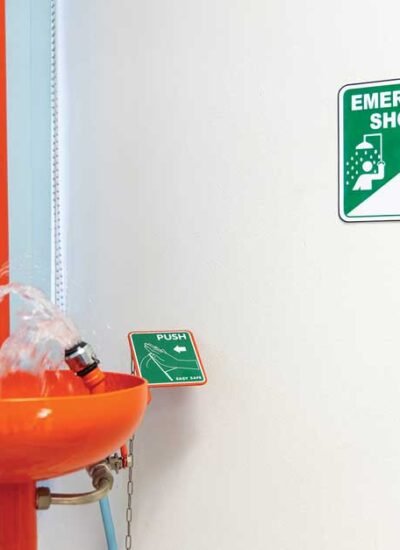In today’s fast-paced industrial landscape, workplace safety is paramount. Whether in manufacturing, laboratories, construction sites, or even commercial kitchens, the risk of exposure to hazardous substances is a reality that employers and employees must proactively address. One of the most critical, yet often overlooked, safety installations is the emergency shower and eyewash station. These stations can mean the difference between a minor incident and a life-altering injury, or even death.
In this blog, we’ll explore the importance of emergency shower and eyewash stations, their role in occupational safety, compliance with regulations, and best practices for their installation and maintenance.
The Critical Role of Emergency Shower and Eyewash Stations
Rapid Response to Chemical Exposures
The primary function of an emergency shower and eyewash station is to provide immediate decontamination for individuals exposed to hazardous substances such as chemicals, corrosives, or biological agents. In the event of a spill, splash, or accidental contact, time is of the essence. Immediate flushing of the skin or eyes can prevent or significantly reduce the severity of injuries like chemical burns, eye damage, or long-term health issues.
According to the Occupational Safety and Health Administration (OSHA), emergency showers and eyewash stations are considered essential first-aid equipment in environments where employees are exposed to harmful substances. OSHA’s standards (29 CFR 1910.151(c)) state that suitable facilities for quick drenching or flushing must be provided when employees may be exposed to injurious corrosive materials.
Safeguarding Employee Health and Reducing Liability
Aside from regulatory requirements, the presence of an emergency shower and eyewash station demonstrates a company’s commitment to employee health and safety. This proactive measure reduces the risk of severe injuries, which in turn lowers workers’ compensation claims, medical costs, and potential legal liabilities.
Moreover, investing in such equipment can foster a culture of safety, enhancing employee morale and retention. Workers who feel their employer cares about their well-being are more likely to stay engaged and loyal to the organization.
Regulatory Requirements and Compliance
ANSI/ISEA Z358.1-2014: The Industry Standard
In addition to OSHA regulations, the American National Standards Institute (ANSI) and the International Safety Equipment Association (ISEA) have established the ANSI/ISEA Z358.1-2014 standard. This guideline provides detailed requirements for the design, performance, installation, and maintenance of emergency shower and eyewash stations.
Key highlights of the standard include:
- Location: Stations must be located within 10 seconds (about 55 feet) of the hazard.
- Flow Rate: Emergency showers must deliver a minimum of 20 gallons per minute, and eyewash stations at least 0.4 gallons per minute.
- Temperature: Flushing fluid must be tepid, defined as 60°F to 100°F (16°C to 38°C).
- Accessibility: Stations must be on the same level as the hazard, with unobstructed access.
- Duration: The station must provide a continuous flow for at least 15 minutes.
Importance of Regular Inspections
Simply installing an emergency shower and eyewash station isn’t enough. Regular inspections and maintenance are crucial to ensure the equipment functions correctly in an emergency. ANSI recommends activating eyewash stations and showers weekly to verify operation and flush out any sediment or stagnant water. Annual inspections should also be conducted to ensure full compliance.
Where Are Emergency Shower and Eyewash Stations Needed?
High-Risk Industries
While all workplaces should assess the need for emergency decontamination stations, certain industries face heightened risks and typically require these installations:
- Chemical Manufacturing: Frequent handling of hazardous substances makes emergency showers and eyewash stations non-negotiable.
- Laboratories: Accidental spills and splashes during experiments pose constant hazards.
- Oil and Gas: Exposure to petroleum products, solvents, and chemicals can lead to severe burns and injuries.
- Pharmaceuticals: Handling active pharmaceutical ingredients (APIs) necessitates immediate decontamination capabilities.
- Food Processing: Use of cleaning agents and sanitizers can lead to accidental exposure.
Hazard Assessments
Employers should conduct a thorough hazard assessment to identify areas where the risk of chemical exposure exists. This assessment should consider the types of substances handled, quantities involved, and the layout of the workspace.
Best Practices for Installation and Maintenance
Strategic Placement
Emergency shower and eyewash stations should be placed in easily accessible and clearly marked locations. Signage should be visible from a distance, and adequate lighting should ensure the station can be found quickly, even during a power outage.
Considerations include:
- Avoiding areas with obstructions or potential trip hazards.
- Ensuring clear paths from all workstations to the emergency equipment.
- Additional units can be installed if one station cannot cover all hazard zones.
Training and Drills
Employees must be trained in the proper use of emergency showers and eyewash stations. This includes knowing how to activate the equipment, how long to flush, and how to report incidents. Regular drills can reinforce this knowledge and ensure that workers can respond effectively in a real emergency.
Maintenance Schedule
Implement a strict inspection and maintenance schedule, including:
- Weekly activations to verify proper flow and temperature.
- Annual full inspections in accordance with ANSI guidelines.
- Immediate repairs or replacements for damaged or non-functional equipment.
Documenting these activities is essential for compliance and legal protection.
The Human Impact: Stories from the Field
Consider the case of a laboratory technician who accidentally splashed a corrosive acid onto her face and eyes. Without an accessible emergency shower and eyewash station, the technician suffered severe burns and permanent eye damage. Contrast this with another workplace where a worker exposed to a similar chemical was able to reach an emergency station within seconds. After 15 minutes of flushing, the employee was treated at a medical facility and made a full recovery.
These real-world examples underscore the life-saving potential of emergency shower and eyewash stations.
A Small Investment with Huge Returns
An emergency shower and eyewash station may seem like a minor piece of equipment in the grand scheme of workplace infrastructure, but its importance cannot be overstated. In an emergency, every second counts. Having these stations readily available can prevent injuries, save lives, and protect businesses from costly legal battles and reputational damage.
Ensuring that your workplace is equipped with properly installed, maintained, and tested emergency showers and eyewash stations isn’t just about regulatory compliance—it’s about creating a culture of safety, care, and responsibility.
If you haven’t already assessed your facility’s emergency preparedness, now is the time. Your employees’ health and safety—and the future of your business—depend on it.





Leave a Reply